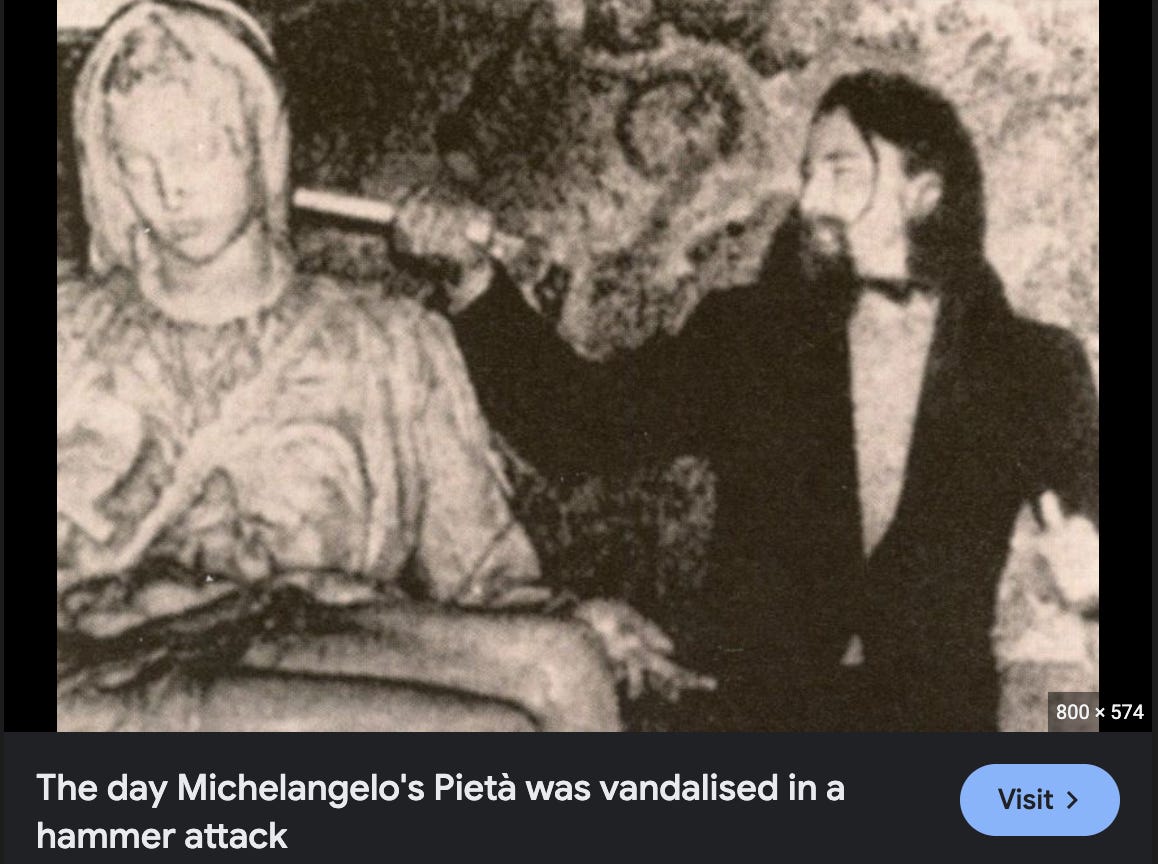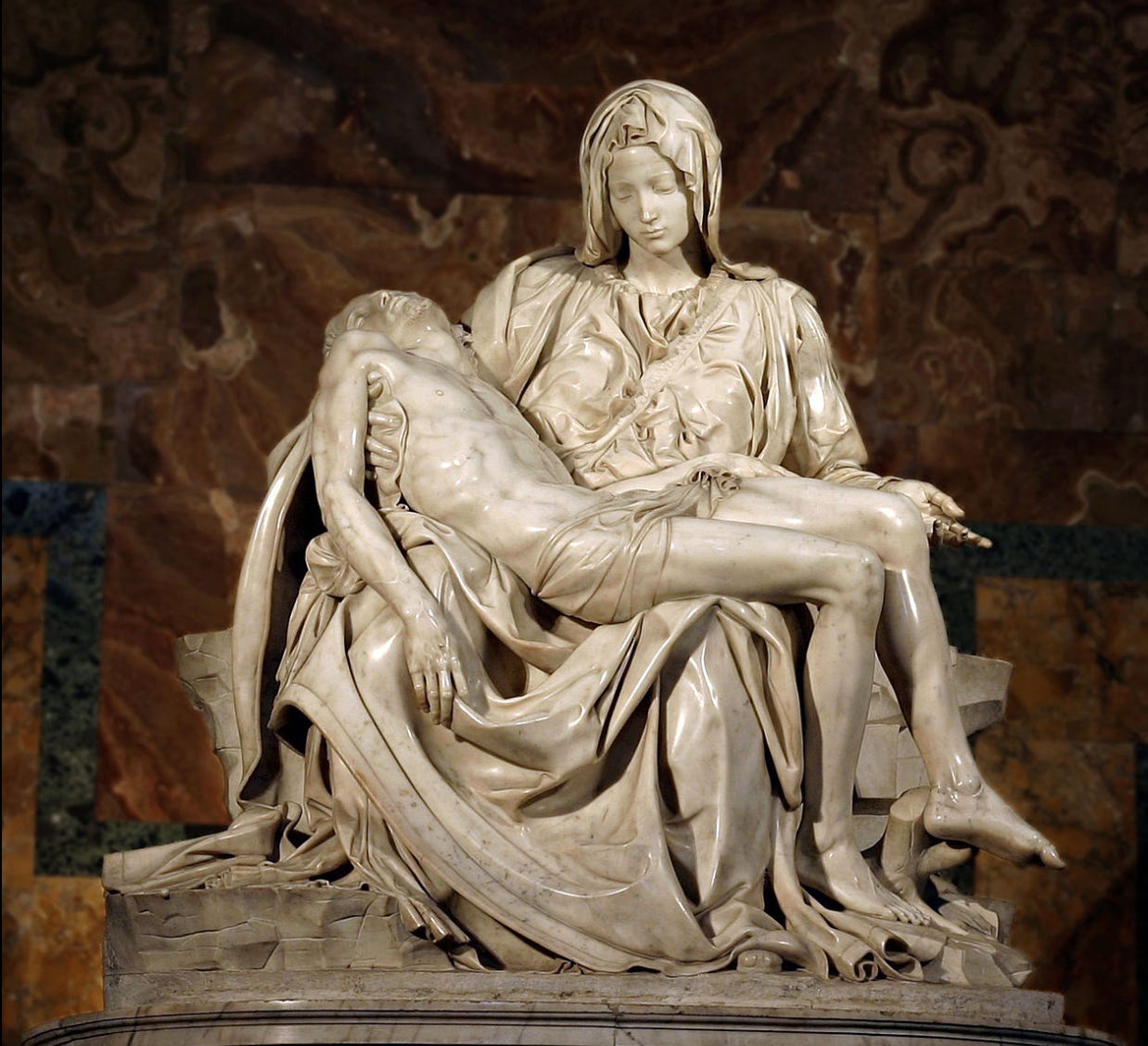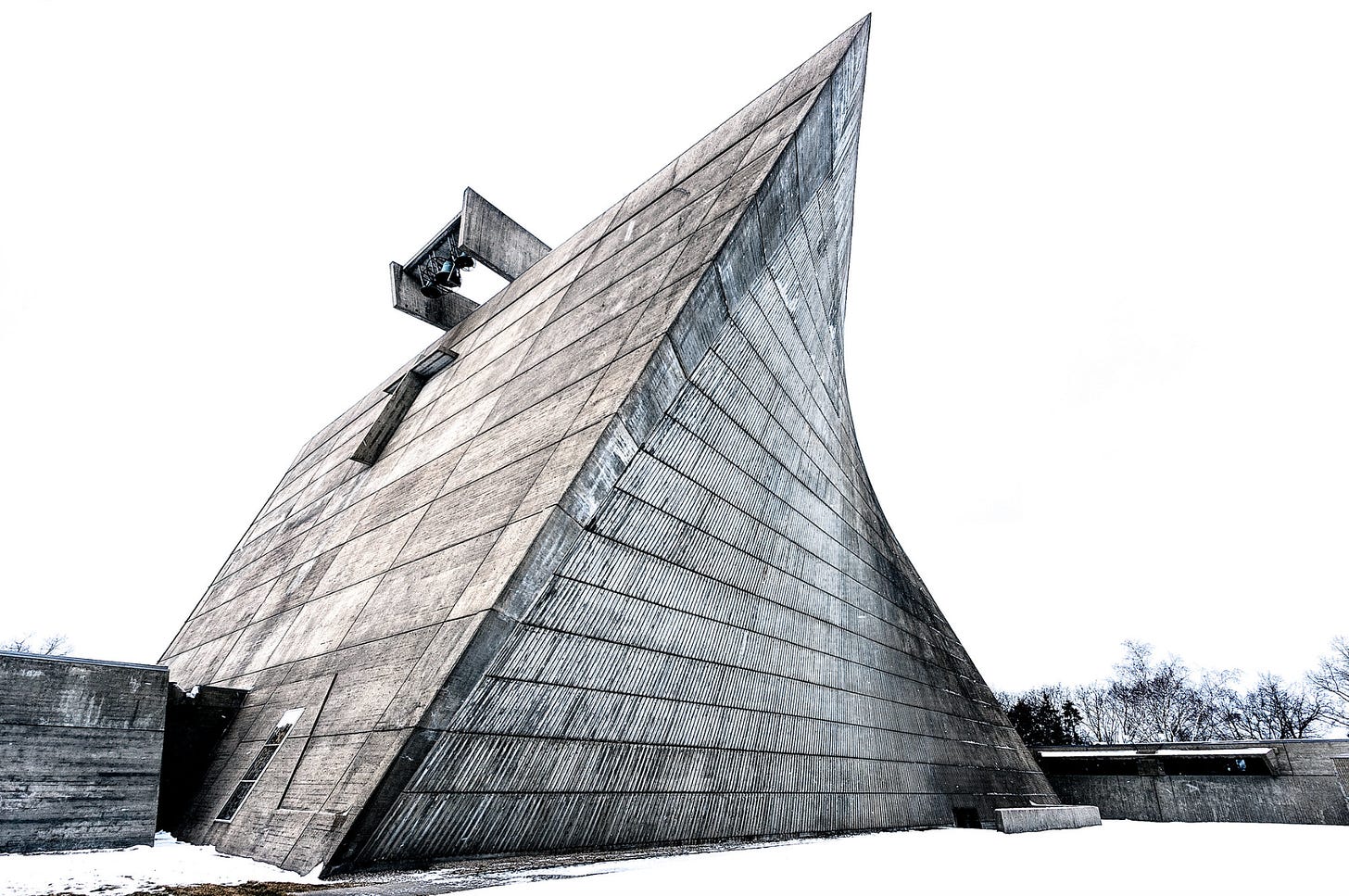My movie review of "The Brutalist"
Is this the greatest film of the decade, like the critics say?
The Brutalist is one of the two front-runners for the Best Picture Oscar according to professional oddsmakers.
Yet, the critically lauded 3 hour and 35 minute film written and directed by Brady Corbet strikes me as a remarkable howl of anti-Semitic-adjacent rage by an art house auteur who despises the (largely Jewish) money men who dominate film industry greenlighting.
Of course, Corbet, not being Jewish, can’t make that movie.
So The Brutalist flips who-whom around 180 degrees and masquerades instead as a perfectly respectable anti-gentilic period piece about how a Holocaust-survivor immigrant Jewish Bauhaus architect is raped (quite literally) by his rich WASP patron, who spouts an anti-Semitic diatribe while doing the dirty deed.
It’s a truly loony bit of Hate Cinema. But, because the word “anti-gentilic” doesn’t exist outside my writings, nobody except me is going to notice.
Granted, a few critics have quibbled that this scene in which American Christian capitalist Harrison Lee Van Buren (57-year-old Guy Pearce of L.A. Confidential and Memento) homosexually violates brutalist Jewish Hungarian architect László Tóth (51-year-old Adrien Brody of The Pianist and Predators) is perhaps a little too on-the-nose of a metaphor for how WASP's oppress Jews, immigrants, and artists.
But they all agree that Corbet’s movie accurately depicts who are the good guys and who are the bad guys in American history.
Still, the more I learn about the filmmaker, the more it sounds like the poor man has … issues.
Corbet, a former child actor who dropped out of high school, doesn’t actually know or care much about architecture. In interviews promoting his movie, he even dodges offering an opinion on whether the big concrete hulk his hero designs for the villain is beautiful or ugly, saying, “I’m not a fan of architecture.”
I’d like to show you a picture of the edifice the hero erects, but there doesn’t appear to be one on-line anywhere. That’s intentional. Corbet admits:
I think in the entire film, like you said, there’s probably only about four minutes of concrete shown…. I liked how the Brutalism is sort of a specter that haunts every frame of the film, where everyone’s kind of waiting for it. I remember thinking, “wow, what a perverse sort of pleasure it would be if I could have the audience sort of waiting and becoming excited about this inanimate object that will eventually be revealed to them.” Ultimately, it’s just a building.
Indeed.
Eventually, the movie reveals that the Holocaust survivor architect designed his Pennsylvania Christian concrete chapel on the dimensions of the Nazi concentration camp he’d survived.
But is that Corbet’s revenge on Christians, even upon small town Pennsylvania gentiles who’d helped the Jewish architect survive Buchenwald by defeating the Nazis for the hero? Or is that Corbet’s subversive commentary on how architecture went to hell in 1945?
Who knows?
That Corbet named his Hungarian Jewish immigrant hero after the Hungarian Catholic immigrant madman who in 1972 took a hammer to Michelangelo’s Pieta, perhaps the greatest Christian statue, raises questions.
But I don’t know what Corbet’s choice of name is supposed to mean, if anything. Most of the rest of Corbet’s symbolism, like naming the bad guy after three Presidents and a Confederate general, or depicting the Statue of Liberty upside-down upon the immigrant’s arrival to show how brutal America will be to the brutalist, is more obvious.
Nor does Corbet know much about what mid-century America was like. For instance, his 1950s characters use phrases like “significant other,” “government funding earmarks,” and “in the interest of transparency” that nobody employed until decades later. The Coen Brothers could probably tell you to the half-decade when each of these terms entered daily speech. I can’t, but I do remember scoffing at the then-exotic term “significant other” in 1982.
The movie’s role of the Mandatory Magical Negro, who seems to be in the film mostly to show that the architect is a good person, is played by an actor from the Ivory Coast who has an African accent, which 99.99% of blacks in America did not have in 1950.
Conversely, you can tell that the WASP industrialist is a bad person because he is upset to discover a “Negro worker” on his estate. But rich people back then were used to having black servants on their property. It’s only after the 1960s-1970s rise in black crime that the wealthy phased out black service workers in favor of Latinos. Tom Wolfe’s Radical Chic in 1970 reports on how impressed New York’s high society was that conductor Leonard Bernstein had Chileans rather than blacks serve canapés at his fundraiser for the Black Panthers.
An absurdity central to the plot is that the fictional Jewish Hungarian refugee architect must spend the late 1940s in Philadelphia as a homeless day laborer before his European fame is finally discovered after half a decade in America.
In reality, Bauhaus refugees like Marcel Breuer, the ethnically Jewish Hungarian furniture designer and brutalist architect who is the prime inspiration for the fictional Tóth, were treated as conquering heroes from the moment they set foot in the U.S. in the 1930s.
Rather than have to shovel coal upon arrival in 1937, Breuer was instantly made a Harvard professor, given land and money to build his own showcase house next to his boss Walter Gropius’s house, and soon commissioned by a rich man to build him a modernist mansion. (For the hilarious details of the 1940s-1950s frenzy among American elites to employ these legendary Europeans, see Tom Wolfe’s short history of modernist architecture, From Bauhaus to Our House.)
While lots of Bauhaus architects like Breuer, Walter Gropius, and Mies van der Rohe moved to America in the 1930s, where they were rapturously welcomed and showered with desirable work, no Jewish architects fled to America after the war like the hero does in this movie.
Why not?
Because, whether they were in communist Eastern Europe or capitalist Western Europe, modernist architects who survived the Nazis were on the winning sides of World War II, and they could find ample exciting opportunities helping rebuild their blown-up continent.
Consider two prominent real-life Jewish Hungarian architects.
Ernö Goldfinger (who so outraged Ian Fleming’s conservative tastes that he named his most famous Bond villain after the designer) had married an English heiress in the early 1930s and worked in Britain for the rest of his life.
Goldfinger flourished after the war, being commissioned to build the British Communist Party headquarters and then a series of brutalist public housing highrises, most famously the now fashionable Trellick Tower in trendy Notting Hill:
In contrast, Lajos Kozma stayed in Hungary after supporting Bela Kun’s communist revolution in 1919, despite Hungary’s anti-Semitic (but not genocidal) rightwing government. He did well between the wars designing for wealthy home and business owners, but couldn’t get government contracts due to being Jewish and leftist. When Hungary negotiated with the Allies in 1944 to drop out of its alliance with Germany, the Nazis invaded and started rounding up Jews and shipping them to Auschwitz. Kozma went into hiding.
Surviving the war, he was reinstated as an architect, received his first public commission for a school, joined the editorial board of a modernist architecture journal Uj Epiteszet (New Architecture) and was appointed both as a director of the School for Applied Arts and a professor in the School of Architecture at Budapest Technical University. Unfortunately, before the school's new building opened in 1948, Kozma died at age 64.
So, Corbet doesn’t know much about the history or practice of architecture.
But he does know the film business, having worked in it from age seven. So, his violated Jewish architect is clearly a stand-in for his gentile self in his struggles to finance his art house films. From his interview with the Hollywood Reporter:
Q. It’s natural to also read the film as reflecting your personal struggle to make uncompromising art in today’s industry.
A. Well, this is something I think most filmmakers can relate to — because art and commerce are frenemies. Especially in architecture and in cinema. They’re very similar in this regard. You can write a song in your bedroom, but you can’t make this kind of movie that way. You can’t build an ambitious building without dozens of collaborators either. I don’t need as much money as some people need to make movies. This film was made for under $10 million. But I still need millions of dollars. That’s very complicated because it means I often have to interface with people with whom I don’t share the same ethics and morals. Any filmmaker who would say otherwise is being dishonest, because whether it’s the studios or private equity, if you follow the money, it generally doesn’t come from a great place. And so this relationship between the artist and their patrons is something that people don’t talk about enough. I think the reason it’s so taboo is that people are worried that if they talk about it, no one will write them another check — which means they won’t be able to make more work, and they’re not going to be able to take care of their families. And I get that. Cinema, for me, is labor. I can barely keep my head above water financially. Most filmmakers I know in America — they live in one-bedroom apartments until they die. It’s not a very lucrative medium. You work on something for years. You don’t get paid much, or if you do, it’s not enough money to live on for four to seven years until you’re able to get your next film off the ground. It takes a lot out of you. … I’ve had enough of it. I’m tired, you know? I should be able to do my job in peace. [Corbet pauses for a moment after growing emotional] I’m sorry… I’m very emotional today. This film is very personal in the sense that it’s about how many obstacles are put in my path and my wife’s path just to bring our projects to life. This movie should not have taken seven years to get made. But it did — and my cortisol levels are still through the roof.
The business side of movies is by no means all Jewish, but Jews have played a massive role as movie executives for over a century. The classic ethnic history of Hollywood moguls is Neal Gabler’s An Empire of Their Own: How the Jews Invented Hollywood.
I’d say that, on the whole, Jews have done a pretty good job running the American movie business in its conquest of the world.
But I can also understand the resentments of artistes like Corbet.
I’m sure Mr. Corbet would be horrified by my line of thought, and no doubt protest that some of his worst enemies are fellow gentiles, and that his critique is one of class rather than of ethnicity.
Good points, I’d say, but they never seem to work when it’s whites who are being racially libeled for disproportionate representation.
OK, The Brutalist is bad history, but is it fine art? Is this a good movie? Or were the (heavily Jewish) executives whom Corbet hates justified in doubting his talent?
Okay, I’m going to put the paywall here.
Keep reading with a 7-day free trial
Subscribe to Steve Sailer to keep reading this post and get 7 days of free access to the full post archives.








